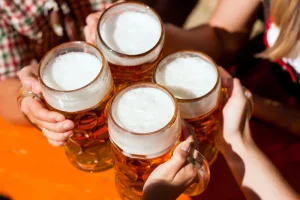
The DSM is a guide that describes and classifies mental disorders, published and updated regularly by the American Psychiatric Association and used as a tool by medical professionals. The more familiar term “alcoholism” may be used to describe a severe form of AUD, but physicians, researchers, and others in the medical community tend not to use the word. Call your doctor whenever you or someone you love has an alcohol-related problem. Remember, alcoholism is not a sign of weakness or poor character. The sooner treatment begins, the easier alcoholism is to treat. It is never easy for family members and friends to talk about a drinking problem.
Charitable Care & Financial Assistance
To learn more about alcohol treatment options and search for quality care near you, please visit the NIAAA Alcohol Treatment Navigator. Alcohol use disorder can include periods of being drunk (alcohol intoxication) and symptoms of withdrawal. Heavy alcohol use can also interfere with the effectiveness of schizoid medication and treatment outcomes, as it makes managing the symptoms of schizophrenia more challenging. Additionally, social and cultural factors can contribute to the use of alcohol as a coping mechanism. Drinking is often seen as a socially acceptable way to ‘loosen up’ and have fun, because of which alcohol is frequently served at social events and gatherings. Alcohol is often used as a coping mechanism because it can produce feelings of relaxation and generate euphoria in mind, which can temporarily alleviate stress and anxiety.
A Note on the Modern Understanding of Alcohol Use Disorder
In some cases, the first step in treating alcohol use disorder is detoxification—experiencing withdrawal in a safe setting with medical professionals. Alcohol use disorder affects millions of people, but it often goes undetected. If you’re worried about a loved one’s drinking habits, you may want to think about doing an intervention.

Progressive Symptoms

Alcohol consumption was also linked to a greater risk for stroke, coronary disease, heart failure, and fatally high blood pressure. However, it’s difficult to discern if drinking was the primary problem, or whether lifestyle choices such as diet and exercise influenced health outcomes as well. The later stages of addiction can yield physical changes, but behavioral signs can help detect it early on. People with an addiction often develop rigid routines that revolve around uninterrupted access to alcohol and other drugs; they may be irritated by schedule changes and blame their frustration on others.

Without such a resolve, achieving long-term sobriety is unlikely. Are you concerned that you or someone you know may be dependent on alcohol? Find out how to recognise the common signs, and where to go for help. Can new treatments like GLP-1 drugs and MEAI help break the cycle? The idea that altered forms of consciousness such as mania or alcohol can enhance creativity is a popular belief. Researchers found that participants who had a few drinks were better and faster at creative problem solving than their sober counterparts.
- Loved ones can provide immeasurable support, but they almost take care of themselves throughout an often difficult journey.
- Most medically managed or monitored rehabilitation programs last less than two weeks.
- The miniseries is also important because it spotlights how Purdue Pharma has been influential in allowing the cycle of addiction to continue for so many people.
- It can involve withdrawal symptoms, disruption of daily tasks, discord in relationships, and risky decisions that place oneself or others in danger.
- Alcoholism is a treatable disease, with many treatment programs and approaches available to support alcoholics who have decided to get help.
- Cognitive behavioral therapy is another path, available in person or online.
About 1 in 5 people admit that they sometimes drink more than they “should.” Try setting limits on your drinking, tracking how much you consume, or finding alcohol-free ways to relax and socialize. If you think you might have an AUD, see your health care provider for an evaluation. Your provider can help make a treatment plan, prescribe medicines, and if needed, give you treatment referrals. In order to be diagnosed with AUD, a person must experience any two of these Sober living house symptoms within the same 12-month period. Other early signs of alcoholism include blackout drinking or a drastic change in demeanor while drinking, such as consistently becoming angry or violent.
- Group meetings are available in most communities at low or no cost, and at convenient times and locations—including an increasing presence online.
- Too much alcohol affects your speech, muscle coordination and vital centers of your brain.
- But as you continue to drink, you become drowsy and have less control over your actions.
- Your days probably revolve around drinking and when you’ll have your next drink.
It can cause changes to the brain and neurochemistry, so a person with an alcohol addiction may not be able to control their actions. Healthcare providers diagnose the condition by doing a physical examination to look for symptoms of conditions that alcohol use disorder may cause. Behavioral treatments—also known as alcohol counseling, or talk therapy, and provided alcoholism by licensed therapists—are aimed at changing drinking behavior. Several evidence-based treatment approaches are available for AUD.